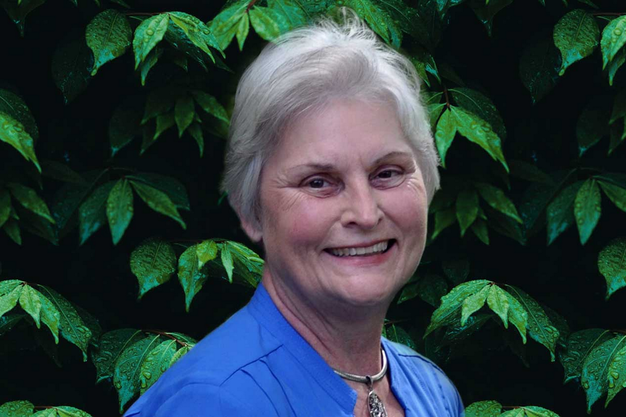Postharvest physiology is important to growers, shippers, and ultimately consumers. When thinking of postharvest physiology, most people know that refrigerating harvested fruits and vegetables is expected to extend their shelf life. However, there are many aspects to NC State's postharvest physiology research into how plants respond to different technologies and methods to help them stay fresher longer, maintain quality, resist aging, and hold onto the phytonutrients needed for human health.
Based in Kannapolis at the Plants for Human Health Institute (PHHI), Professor Penelope Perkins-Veazie focuses on the quality of how produce looks, smells, tastes, and color or sensory attributes, as well as, food safety and nutritional value from the field to the cellular level. Understanding how fresh foods can last longer, taste better, and provide more dietary phytonutrients for a growing market is critical.
Recently, Perkins-Veazie was recognized with the Chad Finn Ambassador Award by the American Pomological Society for significant contributions to the fruit industry, especially in service and outreach. As part of Perkins-Veazie's recognition, she was able to select a graduate student mentee, Brianna Haynes, to attend the American Society of Horticultural Science conference, Sept. 23-27 in Honolulu, Hawaii, and present their research.
Perkins-Veazie has taken a moment to reflect on what led her to postharvest physiology and her passion for research and mentoring graduate students.

What inspired your interest in horticulture?
I was raised in a rural area of Maine, where my highlight of the very short summers was planting and enjoying the few flowers that could take the cold. My most dreaded task was picking green beans in a cloud of mosquitoes. I also picked up apple drops in the fall at a local orchard and still remember those misty cold mornings highlighted by the red fruit on the trees and the fruity fragrance of the air.
Your work is very diverse. What led you to postharvest physiology research in fruits and vegetables?
I had several friends working in postharvest research of vegetables and fruit crops at the University of Florida and I enjoyed seeing what they were working on and the problems being addressed. I was working on a production-focused project for a doctorate when my advisor took over as department chair and needed to pare down his student load. Luckily, the postharvest specialist was happy to have me come on board. Trying to figure out how to make strawberries last longer and how this worked at the cellular level after harvest hooked me on the challenges of postharvest physiology.
What is your research focused on? Do you have any favorite fruits or vegetables that you work with?
Much of my early profession was practical, in evaluating the shelf life of new crops or how to extend that shelf life. That led me to discover just how much I liked raspberries. As new information on the role of produce in preventing chronic diseases started to emerge, I found that it was fascinating to discover what plants produced underneath the peel. Even more exciting was being able to interact with nutritionists and biochemists who could follow how phytochemicals were absorbed and interacted in the human body. I like working with small fruits such as blueberry, blackberry, and strawberry, and fruit vegetables such as tomatoes and melons.
How will your research be used in the future?
I've had the great good fortune to see how some of this research has been built on, such as the exploration of the health benefits of watermelon, or the development of year-round availability of blackberries. I expect much of my research will be utilized to help develop small fruits with better consumer-friendly qualities such as firmness or phytochemicals or to mainstream new fruits for consumers. And it may help with understanding how fruits and vegetables stop or prevent DNA mutations in our cells.
Your work is very collaborative. Would you share one of your successful collaborations with us?
One of the most exciting collaborations was with the blackberry cultivar Von, which was selected by Emeritus Professor Jim Ballington. Gina Fernandez, a distinguished professor and small fruit breeder, put Von into advanced trials and it was evaluated by me for postharvest life. I noticed this selection had no red drupe reversion, was firm even after 21 days of storage, and was not astringent. Fernandez decided to release this variety, and now it is a leading variety in Europe for long cane (winter fruit) production.
What's it like working with and mentoring students?
It's always energizing when a student who has demonstrated observational skills, self-motivation, and the ability to make informed decisions starts learning the next steps in the profession. Watching a student fit together training in lab and field protocols, learn how to do independent research, and apply these skills to answer a scientific question is the best reward.
Has there been a highlight of your career and working with the Horticultural Science and Plant for Human Health (PHHI)?
It's incredibly stimulating to work with faculty that have similar interests in plants and value horticulture; the students contribute fresh viewpoints and so much enthusiasm. One highlight has been muscadine grapes, where work at PHHI showed value in these grapes for health. Continued industry interest in building a market share led to collaborative projects both on storage projects and research on the pigments of seedless grapes and those from Muscadinia hybrids. The information coming in from multiple sources helped develop a new seedless muscadine segment for the industry and has led to a national grant project to better integrate muscadines into the global grape commodity.
Source: NC State Horticultural Science.
